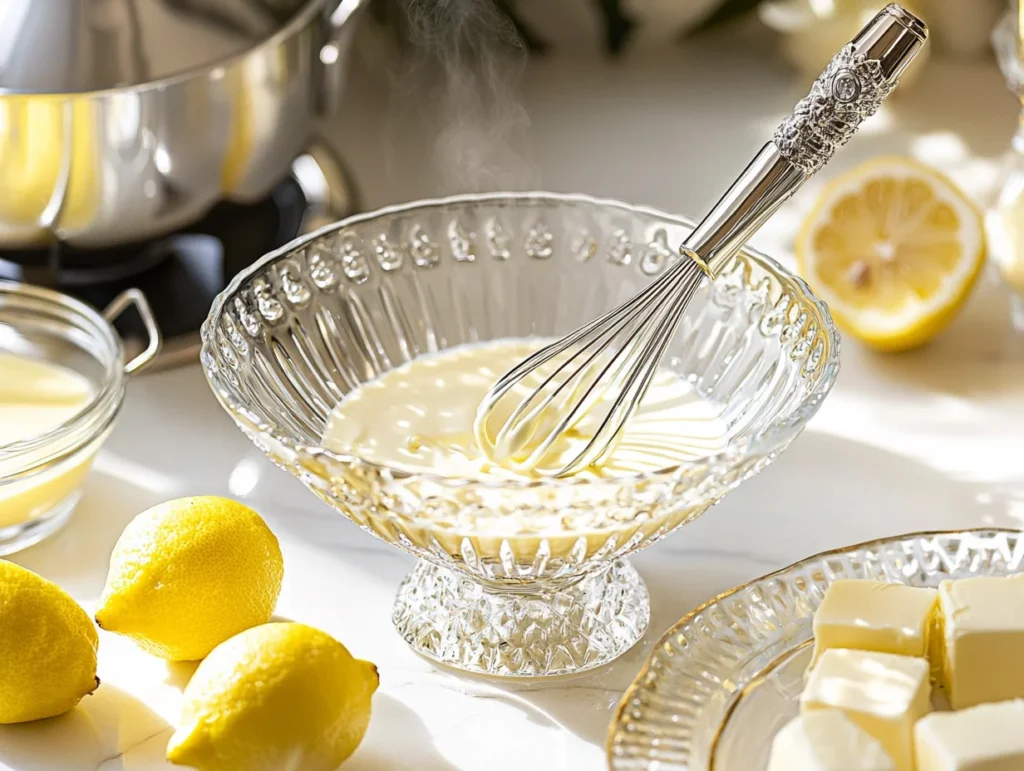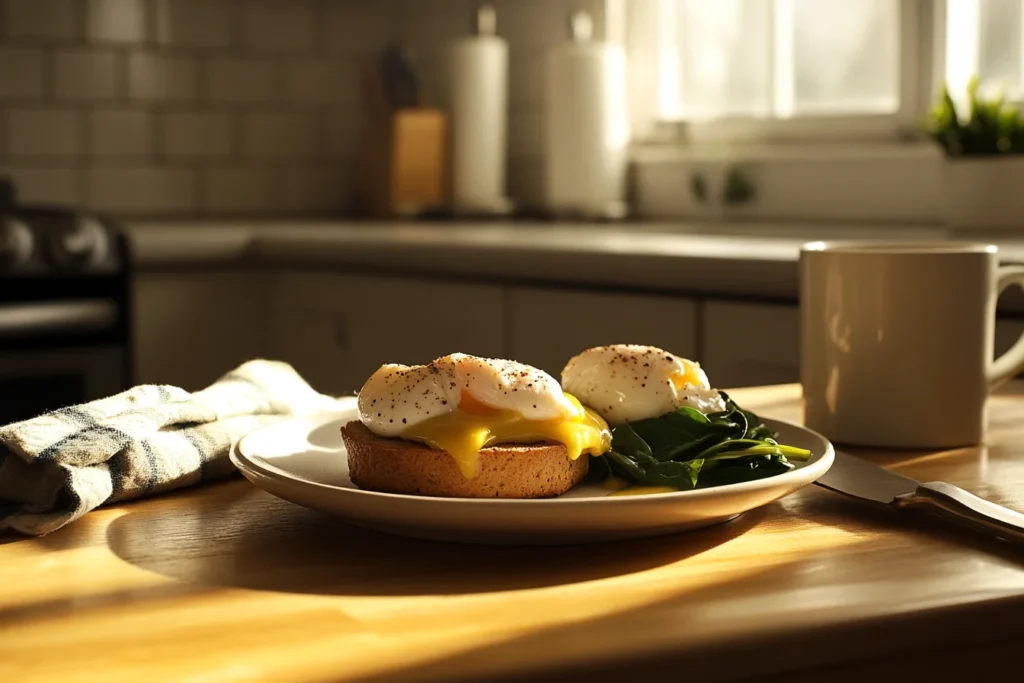“Is eggs benedict healthy?” That’s exactly what I asked Evan the morning after we’d pulled an all nighter with our teething toddler and were desperate for something indulgent… but not guilt inducing.
It had been one of those nights, Rachel pacing the hallway with Nora strapped to her chest in the baby carrier, and Evan frantically Googling “sleep tips for babies” at 3 a.m. By sunrise, we needed two things: coffee (by the gallon) and a cozy breakfast that felt like a treat, but wouldn’t send us into a food coma. That’s when Evan got this glimmer in his eye and said, “Let’s make Eggs Benedict, but lighter.”
And here’s the surprise twist: Yes, eggs benedict can be healthy, or at least healthier, with a few clever swaps. Whether you’re chasing toddlers, rushing to Zoom calls, or simply looking for smarter healthy breakfast choices, this version delivers the buttery goodness you crave… without the heavy after feast regret.
Table of Contents
Why You’ll Love This Healthier Eggs Benedict
There’s a reason this dish shows up on brunch menus across America, it’s comfort food royalty. But we’ve taken this creamy, dreamy classic and reimagined it with your busy lifestyle (and waistband) in mind.
- Protein packed from the poached eggs
- Whole grains in the English muffin
- Greens and lean meats sneak in nutrition without sacrificing flavor
- A lightened up hollandaise that still feels indulgent but is way easier on your digestion
Ingredients
Here’s what you’ll need to make our guilt free take on eggs benedict:
For the base:
- 2 whole grain or sprouted wheat English muffins, split and toasted
- 4 large eggs (fresh is best for poaching)
- 1 tbsp white vinegar (for poaching water)
- 1 cup fresh spinach (or arugula)
- 4 slices Canadian bacon or lean turkey ham (or avocado for a vegetarian twist)
For the lighter hollandaise:
- 3 egg yolks
- 2 tsp Dijon mustard
- 1 tbsp fresh lemon juice
- ¼ cup plain Greek yogurt
- 2 tbsp unsalted butter, melted
- Salt and pepper, to taste
- Pinch of cayenne (optional, but we highly recommend it)
How to Make It
Step 1: Lighten Up That Hollandaise

In a heatproof bowl, whisk together the egg yolks, Dijon, lemon juice, and yogurt. Place the bowl over a pot of gently simmering water (not boiling) and whisk constantly. Once it starts to thicken, slowly drizzle in the melted butter while continuing to whisk. Add a pinch of salt and a dash of cayenne if you like it spicy. Take it off the heat once it’s warm and silky, avoid overcooking.
Rachel’s tip: If you’re multitasking (who isn’t?), this sauce can be made ahead and gently reheated. We’ve done it in a Thermos during family road trips. No judgment.
Step 2: Poach Like a Pro

Fill a saucepan with 2-3 inches of water and add vinegar. Bring it to a gentle simmer, not a bubbling boil. Crack your eggs into separate ramekins or small cups. Gently swirl the water, then slide in the eggs one by one. Cook for 3–4 minutes for that perfect, gooey yolk. Use a slotted spoon to lift the eggs out and place them on a paper towel to drain.
Evan’s tip: For neater poached eggs, crack the egg into a fine mesh strainer to let the thin whites drain out first. It might seem minor, but it really makes a noticeable difference.

Step 3: Toast, Stack, and Smile
Toast your English muffins, then layer on the spinach (a sneaky green boost), followed by warmed Canadian bacon or your protein of choice. Top with the poached egg and drizzle that luscious hollandaise over the top. Add a sprinkle of pepper or chives for that “I brunch professionally” look.
Small Changes, Big Flavor: Why This Version Works

The beauty of this recipe is how it turns indulgence into intention. We’ve swapped out calorie heavy hollandaise for a yogurt based version that still delivers creaminess. Canadian bacon brings leaner protein, and spinach sneaks in a serving of greens without fuss.
Wondering if eggs benedict is healthy when you eat out? Probably not. Traditional versions are often loaded with butter and served on white bread with a side of fried potatoes. But with this homemade option, you get the flavor you crave and the peace of mind that you’re making smart healthy breakfast choices.
Tips from Our Kitchen to Yours about “Is Eggs Benedict Healthy?”
- Use a blender for the hollandaise if whisking sounds like a hassle. Just blend everything (except butter), then stream in melted butter while it’s running.
- Poach eggs ahead and keep them in a bowl of cold water in the fridge. Reheat in warm water for a minute when ready.
- Add avocado for a creamy twist and some healthy fats, it’s a game changer.
A Quick Memory from the Preston Table
This dish has turned into a weekend tradition in our home. We put on jazz, let Nora toss (clean) whisks around the kitchen, and take our time. It’s the kind of breakfast that slows you down in the best way. And when Evan’s mom visited last spring, she said it reminded her of the brunches his grandma used to host, minus the full stick of butter.
FAQs: Making Healthy Eggs Benedict at Home
Can I substitute regular bacon for Canadian bacon?
Sure, but keep in mind it’s higher in fat. For a lighter option, try turkey bacon or even smoked salmon.
What if I don’t like poached eggs?
No problem, soft boiled or over easy eggs work just fine here.
How can I store leftovers?
Store each element separately. Poached eggs can chill in water, sauce in a sealed container. Reheat gently before assembling.
Can I make this gluten free?
Absolutely, just use your favorite gluten free English muffin or even a sweet potato round as the base.
Are Eggs Benedict good for you?
They can be. Traditional Eggs Benedict is definitely on the indulgent side thanks to buttery hollandaise and white bread, but with a few smart swaps, like whole grain muffins, Greek yogurt in the sauce, and lean protein, you can turn it into a balanced, satisfying meal. It’s all about how you build it.
Why are Eggs Benedict so high in calories?
Most of the calories come from the rich hollandaise sauce (hello, butter and egg yolks), the English muffin, and any fatty meats like bacon. Add it all up, and it’s a brunch bomb. But making it at home gives you control over the ingredients, and that’s where you can lighten things up without losing flavor.
How many calories are in an Egg Benedict?
The classic restaurant style version usually clocks in at 600–800 calories per serving, depending on portion size and sides. Our healthier homemade version brings it closer to 350–450 calories, depending on your protein and sauce choices. Big difference, same great taste.
Are poached eggs healthy?
Absolutely. Poached eggs are one of the healthiest ways to enjoy eggs since there’s no added fat from frying or scrambling in butter. They’re high in protein, packed with nutrients like B vitamins and choline, and they keep you full longer. Win win.
Explore More Wholesome Brunch Ideas

Looking to make smarter breakfast choices? If you’re wondering is Eggs Benedict healthy, you might also enjoy exploring some delicious alternatives. Try the Florentine Eggs Benedict for a veggie packed twist, or the Salmon Eggs Benedict for a boost of omega 3s. These options can offer similar flavors with added nutritional perks.
Whether you’re planning a brunch party or just trying to survive Monday with grace, our lighter take on this classic proves that the question “is eggs benedict healthy?” doesn’t have to come with a sigh. With a few thoughtful swaps, it’s not only possible, it’s pretty darn delicious.
And if nothing works, simply pour in a bit more coffee. We’ve all been there.
